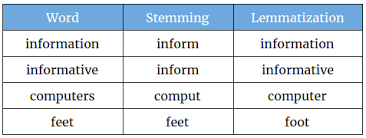Stemming vs Lemmatization Difference: Explained in Detail
 Naveen
Naveen- 0
Introduction
When dealing with large amount of text data, it becomes essential to preprocess and analyze the text effectively. Stemming and lemmatization are text processing techniques that help reduce words to their base forms, helps you in better analysis and understanding.

Stemming
Stemming is a technique that aims to reduce words to their root form, also known as the stem. It involves removing prefixes and suffixes from words and considering linguistic rules and patterns. Sometimes the output word may not contain any meaning, but it captures the core meaning of the original
How Stemming Works
Stemming algorithms apply different heuristic rules to remove prefixes and suffixes from words. These rules are often based on common patterns observed in that language. The stemming process does not consider the context of the word; instead, the focus is on language rules. Let’s look at the example:
Consider the word “running.” After stemming, the word is reduced to its stem, “run.” Similarly, “cats” becomes “cat” and “jumping” becomes “jump.”
Advantages of Stemming
Stemming is computationally efficient and faster compared to lemmatization.
It can be useful in certain applications where the exact base form of words is not critical, such as information retrieval or search engines.
Lemmatization
Lemmatization, on the other hand, aims to reduce words to their base form or lemma while ensuring that the resulting word is valid word in the language. Unlike stemming, lemmatization considers the context of the word and uses lexical knowledge resources like dictionaries or word corpora to determine the base form accurately.
How Lemmatization Works
Lemmatization involves mapping words to their dictionary form, taking into account factors such as part-of-speech (POS) tags and syntactic analysis. By considering these factors, lemmatization gives a more meaningful base form for a word compared to stemming. Let’s look at the Example:
The word “running” would be lemmatized to “run,” “cats” would become “cat,” and “jumping” would be transformed into “jump.”
Advantages of Lemmatization
Lemmatization generates valid words, ensuring the accuracy of the base form.
It is particularly useful in applications where precise word forms are crucial, such as language translation or text analysis involving semantic understanding.
Conclusion
Stemming and lemmatization are both valuable techniques in text processing, but they differ in their approaches and outcomes. Stemming provides a quick and computationally efficient way to reduce words to their root form but sacrifices grammatical correctness. On the other hand, lemmatization produces valid and contextually relevant base forms by considering linguistic resources and syntactic analysis. The choice between stemming and lemmatization depends on the specific requirements of the application and the level of precision needed in word analysis.
